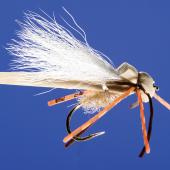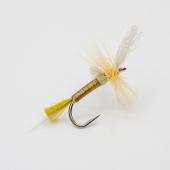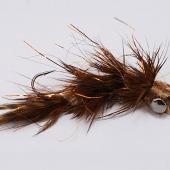Tying a classic caddis dry fly.
In spring, when trout are primarily feeding on caddis, dry-fly fishing becomes one of the most exciting ways to hook a trout. Once the water reaches 50 degrees in mid-March, you’ll see adult caddis hatching on our local waters. As the water warms up, and they begin hatching in larger numbers on bigger freestones and tailwaters, this pattern becomes one of my favorites. The sparkle yarn looks like the trailing shuck of an emerging larva, and the superfine dubbing, deer hair, and hackle create a silhouette that the trout have a hard time resisting. Earlier in the season, try a lighter tan variation in size 14 or 16. Then, during the Mother’s Day caddis hatch, fish a darker olive variation in size 18.
Materials
Hook: Ahrex FW510 14-18
Thread: 8/0 Veevus
Tail: UV2 sparkle yarn
Body: Superfine dubbing
Wing: Deer hair
Hackle: Dark dun cape
Instructions
1. Start the thread behind the eye of the hook and make a few tight wraps.
2. Fold a strand of sparkle yarn around your thread and lash it to the top of the hook shank. Stop just past the hook’s barb. Trim the tail so it’s equal to the length of the hook shank.
3. Using a tiny amount of superfine dubbing, create a short, slim dubbing-noodle and make a slightly tapered body moving up the shank of the hook. Stop about two hook-eye lengths behind the eye of the hook.
4. Take a small clump of deer hair, brush out the underfur, and align the tips using a hair-stacker. Snip the butts of the aligned hairs so that they’re slightly longer than the body.
5. Tie the hair down by wrapping the thread four-six times with firm pressure to ensure the hair wing won’t spin around the shank of the hook. Then, place a small dab of super glue on the butts to make them more durable. Once the glue soaks in, wrap the thread around the tie-in point of the hairs to make a smooth thread ramp down the hook shank.
6. Strip the hackle fibers 1/8-inch from the stem, and tie in the hackle with the shiny side facing up. Leave your thread just behind the hook eye.
7. With touching wraps, advance your hackle forward, down the thread ramp to just behind the eye. Tie it off securely, and trim the hackle flat on the underside of the fly. This ensures the fly will land properly and cast the correct silhouette.
8. Complete the fly with a three-four turn whip finish. Cut the thread and finish with a small drop of head cement.
Drew Daniels works at Bozeman Fly Supply.









